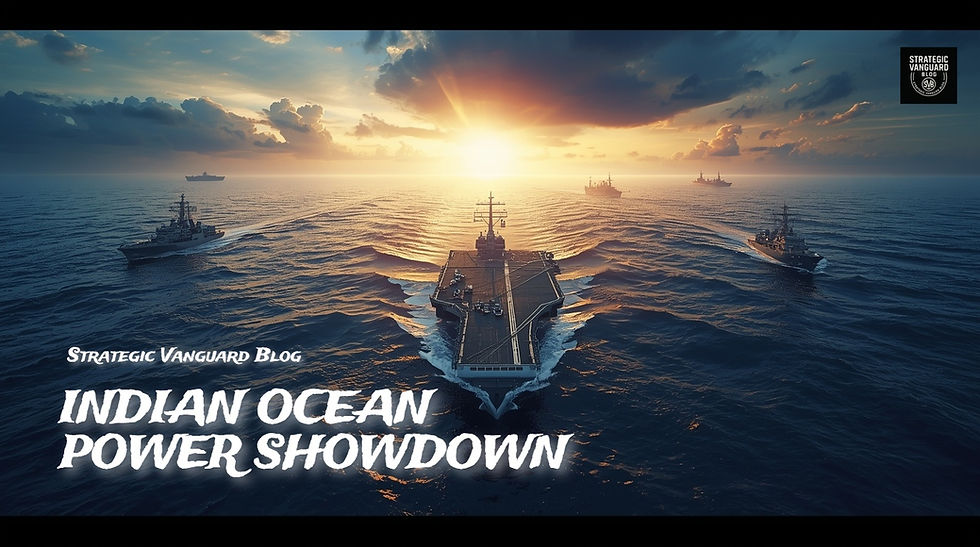Aircraft Carrier Showdown: India vs China in the Indo-Pacific
- Manoj Ambat

- Apr 19
- 2 min read
Updated: Jul 9

In the high-stakes chessboard of the Indo-Pacific, aircraft carriers are the queens—projecting power, protecting sea lanes, and commanding influence over vast maritime territories. As India and China expand their naval footprints, a crucial question emerges:
Who really rules the Indo-Pacific waves—India or China?
🌊 Why Aircraft Carriers Matter
Aircraft carriers are not just floating airbases—they are symbols of national ambition and military reach. In a region like the Indo-Pacific, with over 60% of global maritime trade, carriers provide:
Sea control & air dominance
Power projection across oceans
Rapid-response capability in crisis zones
India and China both recognize this—and are investing heavily in carrier strike groups.
🇮🇳 India’s Carrier Capability
India operates a blue-water navy built around strategic deterrence and freedom of navigation. Its aircraft carriers include:
INS VikramadityaA modified Kiev-class carrier equipped with MiG-29K fighters and advanced sensors. Operational since 2013.
INS Vikrant (IAC-1)India’s first indigenously built aircraft carrier, commissioned in 2022. Displaces over 45,000 tons and symbolizes India’s Atmanirbhar Bharat (self-reliant India) defense push.
India is also planning a third, larger carrier—INS Vishal—which may feature EMALS (Electromagnetic Aircraft Launch System) and catapult-launched aircraft.
🇨🇳 China’s Growing Carrier Fleet
China has shifted from a coastal defense strategy to a far-seas power projection doctrine. Its carriers reflect this bold shift:
Liaoning (Type 001)China’s first carrier, a Soviet Kuznetsov-class design. Primarily a training platform.
Shandong (Type 002)China’s first indigenously built carrier, commissioned in 2019. Ski-jump launch with J-15 fighters.
Fujian (Type 003)A game-changer—fully domestically designed, equipped with EMALS, and expected to operate 5th-gen aircraft. Projected to be operational soon, possibly transforming regional naval power dynamics.
Beijing also plans for nuclear-powered carriers by the 2030s.
⚔️ Carrier Showdown: Head-to-Head
Feature | India 🇮🇳 | China 🇨🇳 |
Operational Carriers | 2 (Vikramaditya, Vikrant) | 2 (Liaoning, Shandong) |
Advanced Carrier | INS Vikrant (45,000 tons) | Fujian (80,000+ tons, EMALS) |
Carrier Aircraft | MiG-29K | J-15, future stealth jets |
Indigenous Capability | High (Vikrant) | High (Shandong, Fujian) |
Carrier Strike Doctrine | Sea control, deterrence | Power projection, A2/AD |
Naval Bases | Andaman, Karwar, Vishakhapatnam | Hainan, Djibouti, Pakistan (Gwadar) |
🧠 Strategy Beyond Steel
India focuses on a multi-layered defense grid, integrating air, sea, and undersea capabilities with QUAD partners and forward-operating bases.
China emphasizes anti-access/area denial (A2/AD) backed by carrier groups, missile systems, and overseas bases to protect its trade routes and geopolitical interests.
📽️ Watch the Full Video Analysis
🎥 India vs China: Aircraft Carrier Showdown in the Indo-Pacific👉 Watch on YouTube
🚨 The Stakes Are High
As both nations deploy larger, more advanced aircraft carriers, the Indo-Pacific is witnessing a transformation. This is no longer a regional rivalry—it’s a global maritime power play.
Whichever nation perfects its carrier strike doctrine, aircraft integration, and joint warfare readiness will command not just sea lanes—but strategic respect.



Comments